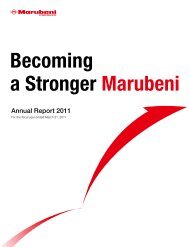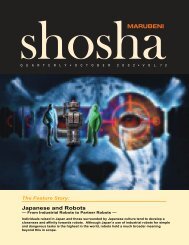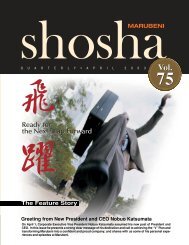Did You Know - Marubeni
Did You Know - Marubeni
Did You Know - Marubeni
You also want an ePaper? Increase the reach of your titles
YUMPU automatically turns print PDFs into web optimized ePapers that Google loves.
Trading in Information — Throughout <strong>Marubeni</strong> and Across the Globe<br />
Quarterly Newsletter · Summer 2007 · Vol. 92<br />
2<br />
6<br />
10<br />
12<br />
15<br />
■<br />
■<br />
■<br />
■<br />
■<br />
COVER STORY<br />
Floating Oasis on the Arabian Peninsula<br />
NATIONAL STAFF<br />
Stepping Forward, Together!<br />
<strong>Marubeni</strong> America Corporation, New York Office<br />
A WORLD OF MARUBENI<br />
Toyota Ghana Company Ltd.<br />
<strong>Marubeni</strong> Europe P.L.C. Oslo Office<br />
HOT OFF THE PRESSES<br />
The Latest News and Updates<br />
JAPAN UP CLOSE<br />
An Exhibition of the <strong>Marubeni</strong> Collection
2<br />
shosha No.92 Summer 2007<br />
Floating Oasis on the<br />
Arabian Peninsula<br />
Al Qaser exterior<br />
Countries on shores of the Arabian Peninsula,<br />
such as Saudi Arabia, Qatar and the<br />
United Arab Emirates (UAE), are most<br />
known for their desert landscapes and<br />
economies rooted in oil production. However,<br />
with their recent trend of funneling<br />
economic resources back into social infrastructure<br />
and the tourism industry, this<br />
reputation is rapidly changing.<br />
"Leading a pair of camels through an oasis" photo image courtesy of private source.<br />
Photo images on pages 1 through 4 courtesy of the Government of Dubai, Department of<br />
Tourism & Commerce Marketing.
More Than Just Palm Trees in the Sand<br />
In recent years, the government of the UAE has been taking<br />
the opportunity to re-invest its economic resources for<br />
creating new jobs for its citizens as well as expanding and<br />
modernizing its government infrastructure. In March this<br />
year, His Highness Sheikh Mohammed bin Rashid Al Maktoum,<br />
Prime Minister and Ruler of Dubai, stressed the<br />
importance of a new Federal Government Strategy which<br />
was recently unveiled. The strategy itself calls for the<br />
upgrade of government performance in tandem with<br />
improving the quality services available to the public. Taking<br />
a personal hand in the implementation of this strategy,<br />
the Prime Minister himself has addressed second and third<br />
level ministers participating in seminars to prepare themselves<br />
for future managerial challenges. Sheikh Mohammed<br />
has been quoted as saying, “<strong>You</strong> should take advantage<br />
of every single minute to improve government<br />
[Cover Story] 3<br />
performance and get rid of red tape” and<br />
has further emphasized that he and his<br />
cabinet would closely follow the implementation<br />
of this strategy.<br />
While the economy of the UAE has<br />
been largely based on oil and gas<br />
resources since 1971, they have always<br />
Leading a pair of camels through an oasis<br />
been investing in the diversification of<br />
their development, looking ahead to the<br />
day when these resources are no longer<br />
available. Beginning with initial investments<br />
in hydrocarbon and petrochemicals,<br />
which still remain important sectors,<br />
they have developed state-of-the-art<br />
manufacturing facilities able to produce<br />
Dubai and Hotel Burj Al Arab<br />
and export a wide range of products, from<br />
pharmaceuticals and jewelry to clothing,<br />
textiles and ceramics. With the availability<br />
of efficient infrastructure and communication<br />
in industrial zones, along with<br />
the UAE’s close proximity to suppliers of<br />
raw materials, further growth and prolonged<br />
economic stability is expected to<br />
Hotel Burj Al Arab interior<br />
continue in these areas.<br />
In addition to manufacturing, the UAE is further stabilizing<br />
and diversifying its economy through development of<br />
its tourism industry, which is one of the fastest growing in<br />
the world. In 2005, an estimated 6.1 million tourists came<br />
to Dubai, and the Abu Dhabi Tourism Authority has established<br />
a target of increasing Abu Dhabi’s annual visitor<br />
numbers to over three million over the next eight years.<br />
And with that in mind, tourism is quickly becoming more<br />
important to Dubai than its income from oil. Quite possibly<br />
often overlooked is the fact that the UAE has all of the natural<br />
ingredients for a great vacation spot like warm shallow<br />
seas, long sandy beaches, first-class shopping malls, an<br />
Dubai International Airport
4 shosha No.92 Summer 2007<br />
Satellite view of the Dubai sea side<br />
Shopping mall in Wafi city<br />
intriguing traditional culture and a safe and welcoming<br />
environment. While the climate is comfortable for most of<br />
the year, in order to further support the tourism industry,<br />
the government has developed resources to lessen the discomfort<br />
of excessive heat through innovative construction<br />
and cooling projects.<br />
Palm Trees in the Sea<br />
As well as government projects to<br />
promote economic diversity and<br />
tourism, private companies are also<br />
investing in the development of the<br />
UAE. Being touted as the Eighth Wonder<br />
of the World, “The Palm Jumeirah<br />
Project”, a project sponsored by<br />
Nakheel Co., LLC in which a five kilometer<br />
long island in the shape of a palm tree, is being constructed<br />
on the Arabian Peninsula. Being made available to<br />
its first guests and residents this year, the new island will<br />
have over 30 of the world’s top hotels, and more than 4,000<br />
luxury residences spread out over 75 kilometers of pristine<br />
beachfront property. But “The Palm Jumeirah Project” is far<br />
from being the only one of its kind in the UAE. “Dubailand”,<br />
a 278 square kilometer amusement park, “International<br />
City” a 300-hectare residential cluster, and “Jumeirah Golf<br />
Estates” a residential golf community with four courses and<br />
luxury residences for over 1,000 families are just a few of<br />
the many projects in various stages of completion and<br />
development.<br />
Tiger in the Palm Trees<br />
When the Prime Minister of the UAE announced the new<br />
Federal Government Strategy for his country this March,<br />
golf legend Tiger Woods announced that he would design<br />
his first golf course to be set for construction in “Dubailand”.<br />
The projected name for this new par-72, 18-hole<br />
championship-quality golf course is “Al Ruwaya” which<br />
means “serenity” in Arabic. The course design will call for<br />
lush landscaping, breath-taking water features and five<br />
tees to suit the beginning golfer as well as the pros. “Al<br />
Ruwaya” will be housed within “Tiger Woods-Dubai”, a luxurious<br />
residential community featuring private homes, a<br />
top of the line clubhouse and a retail community. Construction<br />
of the project is expected to be underway later this<br />
year, with an expected date of completion in 2009.<br />
Creek Golf Club
I<br />
n recent years, <strong>Marubeni</strong> has been involved in a number<br />
of infrastructure support projects on the Arabian<br />
Peninsula. For example, in 2005, an international consortium<br />
including <strong>Marubeni</strong> won the rights to a 23 year large<br />
scale power generation and water project known as Taweelah<br />
B project in Abu Dhabi, UAE. With the purchase of the<br />
existing plant as well as the construction of new facilities,<br />
in terms of production capacity cost, the project itself is one<br />
of the world’s largest independent water and power projects.<br />
Development of power production projects and water<br />
transport systems through cooperation with companies<br />
such as <strong>Marubeni</strong> has aided the UAE in its goal of further<br />
improving its infrastructure.<br />
Also in 2005, with the aim of further improving Qatar’s<br />
infrastructure, <strong>Marubeni</strong> signed a contract for the expansion<br />
of the Doha West wastewater treatment plant and its<br />
10 year operation and maintenance with Degremont, a<br />
<strong>Did</strong> <strong>You</strong> <strong>Know</strong> ? <strong>Marubeni</strong> Construction Projects on the Arabian Peninsula<br />
Artist’s rendition of the Palm Monorail at the Palm Jumeirah<br />
CG image of The Palm Jumeirah<br />
Bird’s eye view of the Taweelah project<br />
[Cover Story] 5<br />
French water treatment engineering company. This<br />
expansion project has increased treatment capacity of<br />
the existing plant to more than double its previous output<br />
of 62,100m 3 /day to 135,000m 3 /day.<br />
Rapid population growth and industrialization have also<br />
led to a need for better and more efficient means of transportation<br />
for citizens. Two years ago, <strong>Marubeni</strong> entered<br />
into a contract with Nakheel Co., LLC for the passenger<br />
monorail transit project in Dubai, known as the Palm Monorail<br />
at The Palm Jumeirah. Completion of the project will<br />
facilitate rapid transport around the island via a high-tech,<br />
well proven driverless monorail system. To further support<br />
industrial diversification in Abu Dhabi, in 2006, <strong>Marubeni</strong><br />
finalized an agreement with the Emirate of Abu Dhabi to<br />
establish a joint venture with General Holding Corporation,<br />
owned in its entirety by the government. This agreement<br />
has resulted in the start of the general trading company<br />
concept in Abu Dhabi in earnest.<br />
<strong>Marubeni</strong> continues to endeavor to provide the highest<br />
level of quality in its construction projects, simultaneously<br />
improving the surroundings of those projects while maintaining<br />
its position at the cutting edge of technology and<br />
international developments.
6<br />
shosha No.92 Summer 2007<br />
Stepping Forward,<br />
Together!<br />
In this edition of “From the Center of the Circle,”<br />
we want to share with you a fresh look at one of<br />
<strong>Marubeni</strong>’s most dynamic overseas offices, the New York City office of <strong>Marubeni</strong> America Corporation<br />
(MAC). There is an air of excitement, and a great spirit of cooperation among all the<br />
employees at MAC these days, and it is our pleasure to share with you some of the reasons why.<br />
N<br />
ew York City, also known as “The Big Apple,” or “The<br />
City That Never Sleeps.” New York City’s business,<br />
finance and trading organizations are significant players in<br />
not only the economy of the United States, but the entire<br />
world. New York is also a global center of culture; according<br />
to the City University of New York, as of 2005, 40 languages<br />
were spoken in the city, and 37% of its population was foreign<br />
born. So it is easy to see why a global trading company<br />
like <strong>Marubeni</strong> would consider its operations there so<br />
important. In the spirit of a song well known by aspiring<br />
karaoke-ists in New York and from all over the globe: “If<br />
<strong>Marubeni</strong> can make it there, it will make it anywhere.”<br />
Howard Tiegel<br />
Senior Vice President and General Manager<br />
of Human Resources<br />
But just how is MAC “making it” at its New York City office?<br />
To find out, you will have to join all of the employees there<br />
as they take you along with them, “Stepping Forward.”<br />
By the end of fiscal year 2005, MAC, including its headquarters<br />
in New York City and twelve other branches,<br />
offices, satellites and showrooms throughout the US, was<br />
already an organization of almost 230 full-time employees<br />
at the holding company level and annual sales, on a consolidated<br />
basis, of more than 7.5 billion USD. In comparison<br />
with the US operations of other Japanese trading companies,<br />
MAC is particularly strong in the fields of chemicals<br />
(including subsidiaries such as Helena Chemical Company<br />
and <strong>Marubeni</strong> Specialty Chemicals), leasing (PLM Trailer<br />
Leasing, Advantage Funding, CoActiv Capital Partners),<br />
and commodities (<strong>Marubeni</strong> Pulp & Paper North America,<br />
Intragrated Resource Holdings).<br />
However, under the <strong>Marubeni</strong> Group-wide “G” PLAN, at<br />
the beginning of fiscal year 2006 MAC was challenged to<br />
increase its profit after taxes to 55 million USD by the end<br />
of fiscal year 2008. With the achievement of this goal and<br />
other “G” PLAN goals in mind, the Human Resources Team<br />
in New York City, led by Howard Tiegel (SVP and General<br />
Manager of HR) and Koji Kashima (then Senior Director<br />
and Assistant General Manager of HR, and now General<br />
Manager of the Planning Section in the Headquarters HR<br />
Department) moved into action, spearheading a project that<br />
sought to foster a positive working environment, promote<br />
strengthened lines of communication and teamwork<br />
throughout all levels of the MAC organization, and maintain<br />
a high level of employee motivation.<br />
Furthermore, in addition to the HR Team members, MAC<br />
executives from the highest levels of the organization lent<br />
their full support to this new project from the very beginning.<br />
In fact, Mr. Shigemasa Sonobe (at the time, Chief<br />
Operating Officer of MAC and now CEO of <strong>Marubeni</strong>
Europe) even lent the project its name when he stated the<br />
importance of “both national staff and rotating staff each<br />
stepping forward together” to bridge cross-cultural gaps<br />
and make a better environment, all toward achieving the<br />
Company’s aggressive business goals. Thus, the “Step Forward<br />
Project!”<br />
1. Maintain a positive working environment through<br />
mutual understanding<br />
At the core of the “Step Forward Project” was the shared<br />
understanding among all staff that although there may be<br />
inherent differences among MAC employees in communication,<br />
leadership, feedback, and risk management styles,<br />
neither a certain “Japanese” style nor a certain “American”<br />
style is better or worse than the other. Rather, the two are<br />
simply different, and MAC could grow a working environment<br />
of sustained understanding and success founded<br />
upon this “hybrid” culture.<br />
Business English lesson for non-native speakers<br />
To build this shared understanding, MAC implemented<br />
and continues to run Cross-Cultural Training for both Rotational<br />
Staff and National Staff in its New York office (and<br />
plans to expand such training to other branches, offices and<br />
subsidiaries across the US). This full-day training is conducted<br />
by Laura Kriska of Japan Intercultural Consulting, a<br />
New York-based consultant specializing in multi-cultural<br />
communication. The main topics include styles of communication,<br />
differences in team versus individual approaches,<br />
hierarchy and organizational styles, time sensitivity, risk<br />
Scenes from tea ceremony workshop<br />
[From the Center of the Circle] 7<br />
tolerance, and performance management styles. “MAC’s<br />
formal training program is the cornerstone of our cross-cultural<br />
understanding,” says Mr. Tiegel, “and we are very<br />
focused on an ongoing dialogue on cross-cultural issues, in<br />
the spirit of kaizen.”<br />
According to Ms. Kriska, “In ten years of cross cultural<br />
consulting, I’ve never seen a company with a stronger program<br />
for transforming cross-cultural barriers into meaningful<br />
connection points between Japanese and non-Japanese<br />
staff through its commitment to training. MAC has achieved<br />
extraordinary results in building cultural understanding<br />
between Japanese and non-Japanese staff to directly<br />
improve communication and teamwork in the workplace.”<br />
In addition to the formal Cross-Cultural Training, MAC<br />
has also introduced more casual “Lunch & Learn Sessions”<br />
to inform the National Staff about Japanese life and culture<br />
in order, as Mr. Tiegel says, “to take the ‘mystery’ out of the<br />
rotating staff.” In other words, “although the rotating staff<br />
may have been born somewhere else, come from a different<br />
cultural background, and speak a different first language<br />
than Americans, they are ‘regular people’ like the national<br />
staff at MAC. If we can all build relationships on an informal,<br />
casual basis, we can work more effectively together, as<br />
a team.”<br />
Through these informal sessions over the lunch hour, in<br />
which both Rotating Staff and National Staff talk together<br />
and share lectures, workshops and demonstrations under<br />
the guidance of facilitator Laura Jackson, the MAC employees<br />
build teamwork through common learning experiences.<br />
According to Ms. Jackson, “Lunch and Learn is a big hit at<br />
MAC and I have seen an increasingly friendly, relaxed connection<br />
between National and Rotating Staff members.”
Upper left and middle: “Taiko club” debut and the Bonsai tree class Upper right: Demonstration of Japanese fencing<br />
Lower left: Trying on kimono Lower right: Practicing Japanese calligraphy<br />
Some topics recently covered include traveling in Japan<br />
and daily life there, as well as its food, art, music, and entertainment.<br />
Also, guest speakers have presented demonstrations<br />
of kendo (Japanese fencing), shiatsu (massage), sado<br />
(tea ceremony), shodo (calligraphy), kimono (formal attire),<br />
bonsai (miniature tree gardening), and taiko (Japanese drums).<br />
One participant commented that “Lunch and Learn is my<br />
favorite program as it gives me a personal insight and better<br />
understanding of Japan’s diverse culture and all that<br />
wonderful country has to offer in so many areas. There is<br />
something for everyone to learn, enjoy and partake in.”<br />
2. Promote increased communication and teamwork<br />
throughout all levels of the MAC organization<br />
In today’s competitive global economy, proficiency in the<br />
local language is essential for uncovering and then successfully<br />
executing business opportunities in any overseas<br />
market. Additionally, in MAC’s case, improving the level of<br />
English proficiency among its employees also led to<br />
improving internal communication as well. The business<br />
English classes conducted at MAC (as instructed by Ms.<br />
Jackson, a professional English teacher who also works<br />
with United Nations diplomats) are open to any staff mem-<br />
ber who would like to participate, so Rotational Staff have<br />
also been joined by National Staff who do not speak English<br />
as their first language, leading to even further strengthening<br />
of communication among employees.<br />
Also, based on the popularity of the Lunch & Learn<br />
Sessions, MAC offered and continues to offer regularlyscheduled<br />
Japanese language courses for National Staff.<br />
The contents include greetings, useful phrases, basic communication<br />
skills, and even hiragana (script writing). In<br />
the words of Sae Okihara, the course instructor, “The students’<br />
enthusiasm towards learning Japanese language and<br />
its culture have become a big motivation for my teaching.<br />
Their positive attitude about the language barrier and<br />
respect for learning have made me realize that interaction<br />
A scene from Japanese<br />
language class
with others is boundless and cultural barriers are easily<br />
overcome through kindred spirits of humankind.”<br />
3. Increase the motivation of all employees<br />
MAC employees and management also knew that improving<br />
internal communication and motivation requires more<br />
than just shared cultural knowledge or a common language.<br />
After all, achieving good internal communication<br />
can be a difficult task even for a completely domestic company!<br />
At MAC, top management now holds a quarterly “CEO<br />
Communication Meeting” to share the “big picture” of<br />
MAC’s operations, as well as those of <strong>Marubeni</strong> Corporation<br />
overall, and also to strengthen all employees’ sense of<br />
belonging to the same MAC team. At each meeting, Michio<br />
Kuwahara (President and Chief Executive Officer of MAC)<br />
gives an explanation of the most recent MAC and <strong>Marubeni</strong><br />
Corporation results, future targets, merger and acquisition<br />
activities, and other key points. Also, following the explanation,<br />
MAC employees are free to ask any questions to Mr.<br />
Kuwahara about the information presented or any other<br />
issue on their mind.<br />
According to Mr. Kuwahara, “Direct communication<br />
between top management and all staff is a driving force<br />
towards building excellent teamwork and motivating all<br />
participants to maximum performance. At MAC we view<br />
communication as essential, and are striving to keep everyone<br />
informed about how important their work is towards<br />
realizing the overall objectives of <strong>Marubeni</strong>. In addition, we<br />
are very proud of all of our staff members at MAC, and their<br />
efforts to continuously improve our business and workplace.”<br />
MAC’s efforts to “step forward” have made an impact on<br />
the bottom line, which is a benefit to everyone.<br />
STEPPING FORWARD, TOGETHER!<br />
[From the Center of the Circle] 9<br />
In closing, we would like to share a few comments<br />
from the MAC employees themselves about the “Step<br />
Forward Project.”<br />
Cathya Espinoza (Logistics and Insurance Team) on Cross-<br />
Cultural Training: “These seminars have helped me to communicate<br />
much better with my managers. Now I know better<br />
what they are expecting, and the reasons for their actions.<br />
Also, they now understand much better how we work.”<br />
Kay Wenzel (Administration Team) on Japanese language<br />
classes and Lunch & Learn Sessions: “While making baby<br />
steps at learning Japanese, I have made big leaps in my<br />
appreciation and empathy for my colleagues who conduct<br />
business in their second language. When I struggle to practice<br />
my latest phrase with them, and we can laugh together<br />
at the difficulties of learning a language, suddenly we feel a<br />
new camaraderie. For me, the resonating theme of the<br />
Lunch and Learn series is that all our ancestors — no matter<br />
which ocean they lived near — had amazing resilience and<br />
creativity. Japan’s culture originated thousands of years<br />
ago and developed independently from my own European-<br />
American culture until very, very recently. So I’m fascinated<br />
to learn how ingeniously, and differently, Japan’s culture<br />
found solutions for all the same human needs and<br />
wants that my culture did, too. Sometimes a Japanese solution<br />
I couldn’t have invented in a thousand years is so effective,<br />
it makes me laugh. Finally, I come away inspired by<br />
the examples of how ingenious and resilient we all can be.”<br />
Estelle Bolofsky (Finance Team) on CEO Communication<br />
Meetings: “It is important to me…to be an integral part of<br />
these quarterly-held meetings. I want to stay aware of our<br />
company’s daily progress and solutions, as well as its longterm<br />
plans. The meetings keep the lines of communication<br />
open and give us as employees a sense of awareness, and<br />
they also serve as learning tools for new employees and<br />
increase motivation toward making improvements and<br />
attaining goals.”
10<br />
shosha No.92 Summer 2007<br />
Ghana and It’s Leading<br />
Auto Company<br />
Toyota Ghana Company Ltd.<br />
B<br />
efore gaining its independence<br />
on March 6, 1957, Ghana was<br />
known as “the Gold Coast” by the<br />
international community. The earliest<br />
Europeans to arrive in this sub Saharan<br />
African country were the Portuguese<br />
in the 15th century. Upon<br />
their arrival, they found so much gold<br />
between the river Ankobra and the<br />
river Volta that they named it da<br />
Mina, meaning “the Mine”. In 1485,<br />
they built the first castle at Elmina in<br />
the Central Region to enhance their<br />
trading activities in gold and slavery.<br />
In 1872, the Dutch traders who had<br />
occupied areas in the Gold Coast for<br />
over 170 years ceded their forts as<br />
free to the British. The British then<br />
became the only Europeans in the<br />
Gold Coast by 1874, making it a crown<br />
colony, thus giving them total control.<br />
Following this, the British government<br />
established its headquarters in<br />
Cape Coast in the Central Region,<br />
which has now become one of the<br />
great historical sites in Ghana.<br />
Gaining independence from the<br />
British in 1957, the Gold Coast subsequently<br />
changed its name to “Ghana”<br />
in accordance with the findings of Dr.<br />
J. B. Danquah, who established that<br />
most of the tribes of the Gold Coast<br />
were descendants of the famous<br />
ancient Empire of Ghana, which had<br />
flourished between the 9th and 13th<br />
centuries. Ghana’s first President, Dr.<br />
Kwame Nkrumah, endorsing Dr. Danquah’s<br />
findings, adopted the name for<br />
the new nation state.<br />
Since July of 1960, Ghana has been<br />
a full Republic. According to UN<br />
statistics, Ghana currently has a population<br />
of 21.8 million people spread<br />
over an area of 238,533 square kilometers<br />
(92,098 square miles). While<br />
English is the official language, it also<br />
has many indigenous Ghanaian<br />
languages spoken within its borders.<br />
World Bank statistics as of 2006 show<br />
that the citizens of Ghana have a per<br />
capita income of 450USD.<br />
In addition to having an abundance<br />
of natural resources available for<br />
export, Ghana has positioned tourism<br />
to become the country’s leading foreign<br />
exchange earner. This is a very<br />
realistic goal considering the number<br />
of attractive tourist destinations in<br />
Ghana such as numerous forts and<br />
castles dotting the coastline, as well as<br />
the Kakum National Park and Canopy<br />
Walk.<br />
Accra, Ghana’s metropolitan capital,<br />
not only being the seat of government,<br />
is also the home of Toyota<br />
Ghana Company Limited, the current<br />
leading Auto Company in Ghana,<br />
wholly owned by <strong>Marubeni</strong>.<br />
Since its inception in April 1998,<br />
Toyota Ghana has been continually<br />
growing, and is currently the auto<br />
industry market leader in Ghana.<br />
a b c d e f g<br />
a Akosombo Dam b Toyota Ghana Company c Kente Weaving d Elmina<br />
Castle e Independence Square f Bead Display g Boti Waterfall<br />
From a sales record of 392 vehicles in<br />
the year 2000, Toyota Ghana sold 1,567<br />
vehicles (about a 400% increase) in<br />
2006. The projected sales figure for<br />
this year, 2007, is 2,000 vehicles, an<br />
almost 25% increase from last year’s<br />
sales. As well as having a strong sales<br />
record, they have also won a number<br />
of national awards including the Chartered<br />
Institute of Marketing, Ghana<br />
(CIMG) Award for “Best Motor Firm of<br />
the Year” for the third time in three<br />
consecutive years. In addition to this,<br />
since the inception of the Ashanti Business<br />
Excellence Awards in 2004, Toyota<br />
Ghana has consistently won the<br />
Award for “Motor Firm of the Year”.<br />
With our corporate slogan of “Quality<br />
That Rewards <strong>You</strong> Everyday”, we<br />
strive to provide nothing but the very<br />
best in customer service to our<br />
clients.<br />
Public Relations Manager<br />
Mrs. Ama Asante<br />
TOYOTA GHANA COMPANY LTD.<br />
Address: Toyota House, Ring Road West Industrial Area, Ghana<br />
Telephone: + 233 21-228813, -245503, -258241, -223122, -221316<br />
Fax: + 233 21-221351 (admin), -222682 (sales)<br />
Established: April 1998<br />
Employees: 225<br />
Business areas: Automotive<br />
Main business products: Sale and service of Toyota vehicles
From the Frosty Fjords<br />
of Norway<br />
<strong>Marubeni</strong> Europe P.L.C. Oslo Office<br />
W<br />
elcome to Oslo! The Norwegian<br />
capital is a small city in terms<br />
of population, with about 550,000<br />
inhabitants. However, in a country<br />
with only 4.5 million inhabitants, Oslo<br />
is a big city. Roughly 1/3 of the Norwegian<br />
population lives on either side<br />
of the Oslo fjord, and Oslo is a natural<br />
centre of this region. Small in population,<br />
but covering 460 square kilometers,<br />
Oslo is large in area. In fact, the<br />
majority of the city area is found in the<br />
hills and forest lands surrounding the<br />
Norwegian capital.<br />
The city’s location at the apex of the<br />
Oslo fjord with the hills in the background<br />
is the key to the quality of life<br />
that people here enjoy; summer days<br />
along the fjord and winter days skiing<br />
in the hills.<br />
Norway is rich in natural resources,<br />
and thanks to a boost in the prices of<br />
oil and natural gas, the country has enjoyed<br />
a boom which has not been seen<br />
since the 1950’s. Norway now ranks<br />
among the top nations in terms of GNP,<br />
and has the luxury of running a large<br />
government budget surplus each year.<br />
To prepare for the age when the oil and<br />
gas revenues will shrink, the surplus<br />
is invested in a fund for the coming generations.<br />
This fund now ranks among<br />
the largest public funds in the world.<br />
Albeit a relatively small city, Oslo,<br />
the Norwegian capital, has all the key<br />
functions of government located here.<br />
Large cultural institutions such as the<br />
National Theatre, The Opera (a new<br />
Opera house will be inaugurated in<br />
2008), The National Gallery and the<br />
Munch Museum are also all located in<br />
Oslo. 60,000 students contribute to making<br />
Oslo a young city with a vibrant<br />
nightlife. The Munch Museum features<br />
the famous “Scream” painting, and so<br />
is always worth a visit, as is the Vigeland<br />
sculpture park on a fine day. The<br />
Viking Ship Museum features 2 actual<br />
Viking ships that were excavated and<br />
are displayed in their simple elegance.<br />
One consequence of the economic<br />
boom has been sharply rising real estate<br />
prices, and Oslo is (unfortunately) one of<br />
the most expensive cities in the world<br />
in terms of living costs, — a pint of beer<br />
will easily set you back about 10 USD.<br />
[A World Of <strong>Marubeni</strong>]<br />
Oslo is an ideal starting point to venture<br />
to the west coast to take in the<br />
fjord scenery there, and the number of<br />
tourists coming to the city is increasing<br />
year-by-year, together with ever<br />
more cruise ships making Oslo and<br />
the Norwegian fjords a part of their<br />
summer itinerary.<br />
<strong>Marubeni</strong> opened the Oslo office in<br />
1971 to link Japanese shipyards with<br />
Norwegian ship-owners. Norway is among<br />
the top seafood exporters in the<br />
world, and Japan is the largest importer,<br />
so it was logical for <strong>Marubeni</strong> to<br />
enter the seafood trade from Norway.<br />
Items handled include mackerel, herring,<br />
farmed salmon and trout.<br />
I would like to take the opportunity to<br />
send my regards to the <strong>Marubeni</strong> family<br />
around the world, and thank all for<br />
their support throughout the years.<br />
General Manager<br />
Carsten H. Holtermann<br />
MARUBENI EUROPE P.L.C. OSLO OFFICE<br />
Address: Professor Dahls Gt. 26, N-0260, Oslo, Norway<br />
Telephone: + 47 2255 8111<br />
Fax: + 47 2255 8112<br />
Established: 1971<br />
Employees: 1<br />
Business areas: Agri-Marine Products<br />
Main business products: Seafood<br />
11<br />
a b c d e f<br />
a A Norwegian Street b Cross Country Skiing c Oslo City Hall<br />
d Fjord and Hills e Vigeland Sculpture Park f Fjord Summer Scene<br />
bottom Viking Ship
12<br />
shosha No.92 Summer 2007<br />
Wood chip biomass power plant in Whitefield, NH<br />
Crossing the<br />
Bosphorus Straits<br />
<strong>Marubeni</strong> Tokyo, with <strong>Marubeni</strong><br />
Corporation Istanbul Main Branch,<br />
formed an international consortium<br />
with the French company Alstom,<br />
and a Turkish company, Dogus,<br />
which has led them to enter into an<br />
official contract worth over 815 million<br />
euros for Phase-2 of the trans-<br />
Front row, from left: Mr.Gemba, Director of Project at<br />
<strong>Marubeni</strong> Tokyo; Mr.Gallocchio, Director of Alstom<br />
Transport; Mr.Talu, Chairman of Dogus Construction,<br />
Mr. Arslan, General Director of DLH Back row, from the<br />
left: Mr. Hoshino, General Manager of <strong>Marubeni</strong> Istanbul<br />
Branch; Mr. Sahin, Under Secretary of the Ministry of<br />
Transport; Mr. Hamza, Deputy Director of DLH<br />
Environmentally Friendly<br />
Biomass Power Plant in the<br />
US<br />
In January, 2007, <strong>Marubeni</strong> purchased<br />
a 16 MW (megawatt) wood<br />
chip biomass power plant located in<br />
Whitefield, NH from Whitefield Power<br />
& Light Company. The acquisition was<br />
completed through <strong>Marubeni</strong> Sustainable<br />
Energy, Inc. which is a 100% subsidiary<br />
of <strong>Marubeni</strong>. By accomplishing<br />
this, the electric generating capacity<br />
of wood chip biomass power plants<br />
owned by <strong>Marubeni</strong> has increased to<br />
approximately 34 MW. The Whitefield<br />
power plant has one of the most advanced<br />
emission control systems,<br />
known as a “Regenerative Selective<br />
Catalytic Reduction” (RSCR) unit,<br />
which reduces nitrogen oxide emis-<br />
Bosphorus rail link project, known<br />
as “Marmaray.” The Marmaray Project<br />
serves as a measure to help mitigate<br />
the chronic traffic congestion<br />
in the city of Istanbul by constructing<br />
an undersea tunnel in the<br />
Bosphorus Strait, with Phase-2<br />
focusing on the construction of new<br />
railway lines as well as the renovation<br />
of existing ones. By winning the<br />
bid for this contract, <strong>Marubeni</strong> will<br />
play an active role through vital construction<br />
projects such as expanding<br />
the current above-ground track<br />
routes along a 63 kilometer (39 mile)<br />
segment, renovating electrification,<br />
signals and IT equipment, as well as<br />
constructing railway stations and<br />
rail yards. In this project, <strong>Marubeni</strong><br />
aims to help alleviate Istanbul’s<br />
growing traffic congestion through<br />
establishing railway lines.<br />
The Bosphorus Strait<br />
sions by more than 70% annually. The<br />
plant utilizes organic materials such<br />
as wood waste and forest residue,<br />
using renewable energy resources<br />
which are environmentally friendly.<br />
<strong>Marubeni</strong> already owns and operates<br />
an 18 MW wood chip biomass power<br />
plant located in Fairhaven, CA.<br />
<strong>Marubeni</strong> believes its experience and<br />
expertise in biomass power generation<br />
will enable it to carry out operations<br />
with high efficiency. <strong>Marubeni</strong><br />
aims to increase its renewable energy<br />
portfolio and expand energy supply<br />
business with distributed generation<br />
facilities to more than 120 MW in<br />
North America by 2010.
Hot strip mill at JSW Steel’s plant<br />
Assistance with Economy<br />
and Trading in the Tangshan<br />
Caofeidian Industrial Zone<br />
In China, <strong>Marubeni</strong> has entered into<br />
a comprehensive trade and economic<br />
cooperation agreement with Hebei<br />
Province’s Tangshan Caofeidian Industrial<br />
Zone. The Chinese government,<br />
in a five-year plan spanning<br />
from 2006 to 2010, has placed a focus<br />
on energy saving and maintaining a<br />
healthy environment as a priority.<br />
With this in mind, the newly constructed<br />
310 square kilometer (193 sq<br />
mile) Tangshan Caofeidian Industrial<br />
Zone is positioned as a model for<br />
China’s first economic circulation system,<br />
as well as a hub port for handling<br />
natural resources and power stations.<br />
Some examples of this concept in<br />
action are, waste heat produced by<br />
industry being utilized by corpora-<br />
tions, and slag leftover from iron mills<br />
being re-used for making cement.<br />
Under this agreement, <strong>Marubeni</strong> will<br />
provide consulting and advice for the<br />
development of a cyclical-type economy<br />
to further improve on the systems<br />
already in place.<br />
[Hot Off The Presses — The Latest News and Updates]<br />
Steel Supply Contract<br />
Awarded in India<br />
<strong>Marubeni</strong> Corporation (<strong>Marubeni</strong>),<br />
in cooperation with Mitsubishi-Hitachi<br />
Metals Machinery, Inc., was awarded<br />
a contract worth approximately<br />
16 billion yen in January by JSW Steel<br />
Limited (JSW), a private Indian company.<br />
During Phase-1 of this contract,<br />
a hot mill supplying 3.5 million tons of<br />
steel annually will be established,<br />
with the option to increase capacity to<br />
5 million tons under Phase-2. At the<br />
moment, JSW Steel has an annual production<br />
capacity of 3.8 million tons of<br />
crude steel, but in order to deal with<br />
the rapid increase in steel demand, it<br />
is implementing an expansion plan to<br />
Front row, from left: Mamoru Sekiyama, Corporate Executive Vice President of<br />
<strong>Marubeni</strong>; Boxun Xue, Administrative Committee of Caofeidian Industrial Zone<br />
Back row, fourth from the left Shuangjian Fu, Vice Governor, Hebei Provincial<br />
People’s Government<br />
13<br />
From the left: Naoki Tsuda, Chairman and Managing<br />
Director of <strong>Marubeni</strong> India Private Ltd.; Arun Mubayi,<br />
President of JSW Steel; Sajjan Jindal, Vice-Chairman &<br />
Managing Director of JSW Steel; Naoaki Izumi of<br />
<strong>Marubeni</strong>; Takafumi Sakishima, <strong>Marubeni</strong> COO of<br />
Plant, Ship & Infrastructure Projects Division; Akira<br />
Odoi, General Manager of <strong>Marubeni</strong> India Private Ltd.<br />
increase annual production to up to<br />
6.8 million tons of crude steel by<br />
2008. With competition from European<br />
suppliers, the contract was given<br />
to <strong>Marubeni</strong> as a result of JSW’s consideration<br />
of <strong>Marubeni</strong>’s ability to<br />
coordinate. There are a number of<br />
mega steel projects planned in India,<br />
and <strong>Marubeni</strong>, with the success of<br />
receiving this sizable order, will continue<br />
to develop projects in the Indian<br />
market.
14<br />
shosha No.92 Summer 2007<br />
<strong>Marubeni</strong> Establishes an<br />
Alliance with Aeon and<br />
Daiei<br />
<strong>Marubeni</strong> formed a capital business<br />
alliance with Aeon Co. Ltd (Aeon) and<br />
The Daiei, Inc. (Daiei), two major Japanese<br />
retailers. All parties involved<br />
reached an agreement that Aeon could<br />
assist Daiei in regaining its performance<br />
and business profits, based on<br />
the shared business philosophy that<br />
customers always come first. While<br />
many retailers in Japan face a number<br />
of challenges due to significant changes<br />
around them, the collaboration<br />
between <strong>Marubeni</strong>, Aeon and Daiei is<br />
expected to create a new trend in<br />
Japan’s retail industry. This agreement<br />
between the Aeon group and the<br />
Daiei group is also expected to create<br />
an alliance of retailers whose turnovers<br />
will exceed a six trillion yen<br />
profit. Under this plan, <strong>Marubeni</strong> will<br />
make a wide variety of business recommendations<br />
and provide a wide<br />
range of services as an all — around<br />
trading house that maintains a strong<br />
relationship with both Aeon and<br />
Daiei.<br />
At a press conference, from left to right: Mr. Motoya<br />
Okada, President of Aeon; Mr. Nobuo Katsumata,<br />
President and CEO of <strong>Marubeni</strong>; and Mr. Toru Nishimi,<br />
President of Daiei<br />
Developing Uranium Mine<br />
Projects with the Republic<br />
of Kazakhstan<br />
<strong>Marubeni</strong> Corporation, in cooperation<br />
with The Tokyo Electric Power<br />
Company, Inc. (TEPCO), and Chubu<br />
Electric Power Co., Inc., has decided to<br />
participate in new uranium mine<br />
development and production projects<br />
promoted by Kazatomprom, a stateowned<br />
nuclear fuel enterprise located<br />
in the Republic of Kazakhstan. Tohoku<br />
Electric Power Co., Inc. also has<br />
decided to participate in the project,<br />
and is planning to purchase a partial<br />
indirect ownership interest in the project<br />
from <strong>Marubeni</strong>. The project itself<br />
will encompass the development of<br />
the Kharassan uranium mine in<br />
southern Kazakhstan. Test production<br />
is expected to begin in 2007, with<br />
a projected full annual production of<br />
approximately 5,000 MTU (metric<br />
tons of uranium) by around 2014, and<br />
continued production until around<br />
2050. With Kazakhstan holding the<br />
world’s second largest uranium reserve,<br />
the total potential uranium production<br />
from these projects could possibly<br />
be over 160,000 MTU. Earlier in<br />
2006, former Prime Minister Koizumi<br />
and Kazakhstan President Nazarba-<br />
One of the project’s housing facilities in Kazakhstan<br />
under construction at a uranium mining site<br />
yev issued a statement together praising<br />
the “successful materialization of<br />
significant projects in the area of exploration,<br />
development and production<br />
of uranium resources”. This statement<br />
acted as a catalyst for <strong>Marubeni</strong><br />
to play an active role in the project.<br />
The Japanese government and the Kazakhstan<br />
government expect to confirm<br />
their relationship for this project<br />
during the mission led by the Ministry<br />
of Economy, Trade and Industry held<br />
at the end of April this year.<br />
From the right: Moukhtar E. Dzhakishev, President of<br />
National Atomic Company Kazatomprom JSC; Mr.<br />
Nobuo Katsumata, President, CEO and Member of the<br />
Board of <strong>Marubeni</strong> Corporation; Mr. Toshio Mita,<br />
President and Director of Chubu Electric Power Co.,<br />
Inc.; Mr. Hiroaki Takahashi, Representative Director &<br />
President of Tohoku Electric Power Co., Inc.; and Mr.<br />
Tsunehisa Katsumata, President of The Tokyo Electric<br />
Power Company, Incorporated
Paintings and Costumes — Works of Beauty<br />
S<br />
View of the exhibition at the Museum of Kyoto<br />
An Exhibition of<br />
the <strong>Marubeni</strong> Collection<br />
by Tsutomu Sugiura, Art Curator <strong>Marubeni</strong> Corporation<br />
ome 200 works of art, paintings and costumes, owned<br />
by <strong>Marubeni</strong> Corporation were exhibited under the<br />
title “Masterpieces from the <strong>Marubeni</strong> Collection — Beauty<br />
of Pictures and Costumes” at the Kyoto Museum from April<br />
13 to May 27, 2007. The exhibition featured works of art<br />
such as La Bella Simonetta (a portrait of Simonetta Vespucci)<br />
by Botticelli, and material from what is said to be a<br />
kosode worn 400 years ago by a mistress of Toyotomi Hideyoshi<br />
known as “Yodogimi”.<br />
<strong>Marubeni</strong> has an extensive collection of artwork, with a<br />
variety of fine arts and folk crafts, as well as dyed and woven<br />
textiles. The <strong>Marubeni</strong> Collection itself can be divided into<br />
two broad categories. The first would be a collection of<br />
about 400 dyed and woven pieces of apparel and other textiles,<br />
representative of various eras since the 16th century.<br />
The other would be an extensive collection of about 600<br />
paintings from Japan and the West.<br />
In the textile category, the formation of a historical costume<br />
collection began with the purchase of a Noh costume<br />
at an auction in 1929. The main purpose of collecting excellent<br />
examples of textile art such as Noh costumes (worn for<br />
performing Noh drama) and kosode (a robe that evolved<br />
into the kimono) was to contribute<br />
to the progressive<br />
development of designs for<br />
textile products handled by<br />
<strong>Marubeni</strong>. In addition to this,<br />
these textile artifacts have<br />
been preserved in order to<br />
pass on to future generations<br />
some remarkable examples<br />
of the technical aspects of<br />
Japanese textile design. The<br />
company continued to collect textile art as opportunities<br />
arose, and today the <strong>Marubeni</strong> collection of costumes has<br />
become one of the leading collections in Japan.<br />
The kosode costume reproduced here is an excellent<br />
piece produced during the mid-18th century. The upper<br />
half of this beautiful multi-colored kosode is set in a lovely<br />
red and displays motifs of fans, snow crystals and pine-bark<br />
inspired diamonds arranged in white. Depicted within<br />
Multi-colored kosode featuring motifs from the Tale of Genji<br />
[Japan Up Close] 15<br />
these motifs are scenes from the Tale of Genji, written by<br />
the famous female author Murasaki Shikibu a thousand<br />
years ago. Themes taken from titles of certain chapters<br />
from that epic novel — Hahakigi, Utsusemi, Wakamurasaki,<br />
Suetsumuhana and Momijinoga — are embroidered<br />
in silk and metallic threads. On the lower half, an<br />
elaborate beach landscape representing a scene from<br />
Akashi, another chapter from the same novel, is dyed in the<br />
Yuzen style, creating a fine contrast with the upper section.<br />
This identification is based on the depictions of sailing<br />
boats, a hut built from rushes on the beach and a building<br />
visible in the mountains.<br />
The paintings within the holdings of the <strong>Marubeni</strong> Collection<br />
also have accumulated gradually over the course of<br />
many years. The collection derived considerable impetus<br />
from the activities of our costume design research group
16<br />
shosha No.92 Summer 2007<br />
Painting entitled La Bella Simonetta by Sandro Botticelli,<br />
the fifteenth-century Italian Renaissance master<br />
operating in the 1920s and 30s<br />
and other activities including exhibitions<br />
known as Biten held in<br />
Kyoto. These circumstances brought<br />
<strong>Marubeni</strong> into close contact with<br />
the many prominent artists of<br />
Osaka and Kyoto, in the Kansai region<br />
— the birthplace of <strong>Marubeni</strong><br />
Corporation. In this way we could<br />
acquire some of their works. Our<br />
holdings also include works donated<br />
by trading partners on various<br />
occasions. The collection of works<br />
by Japanese artists includes those by Takeji Fujishima,<br />
Saburosuke Okada, Ryuzaburo Umehara and Matazo<br />
Kayama. They were the mainstream of modern painters<br />
since the Meiji period that adopted Western styles.<br />
But, the company came by its overseas paintings through<br />
quite a different way. In 1969, <strong>Marubeni</strong> mounted an exhibition<br />
of European masterpieces in conjunction with the British<br />
QUESTIONNAIRE<br />
What do you think? Please let us<br />
know how we are doing by filling<br />
out a short questionnaire online at<br />
http://www.liaison-kikaku.co.jp/<br />
shosha92/form.html by the end<br />
of September 2007. Five lucky<br />
contributors will receive a gift.<br />
YOUR FEEDBACK<br />
<strong>You</strong>r feedback is always welcome<br />
and appreciated. Please let us<br />
know what topics you would like<br />
us to write about in future issues<br />
by sending an email to<br />
shosha@liaison-kikaku.co.jp.<br />
An Exhibition of the <strong>Marubeni</strong> Collection<br />
Paintings and Costumes –<br />
Works of Beauty<br />
Fair. It was at that time that we imported<br />
from Britain works by Botticelli,<br />
Gainsborough, Corot, Renoir and others.<br />
We subsequently transferred our<br />
emphasis to the School of Paris, acquiring<br />
works by such artists as de Vlaminck,<br />
Dufy, Kisling and Utrillo. Thus,<br />
the body of our company’s collection<br />
of paintings was firmly in place by 1979,<br />
but we discontinued our involvement<br />
in the art business shortly thereafter.<br />
Most notable among the foreign<br />
paintings in our collection are Wooded<br />
Landscape with Peasant Courting a<br />
Milkmaid by Thomas Gainsborough;<br />
Le Kiosque de Ville-d’Avray by Camille<br />
Corot, Les Oliviers de l’Estaque<br />
by Auguste Renoir, La Seine à Chatou<br />
by Maurice de Vlaminck, Bateaux au<br />
Havre by Raoul Dufy; Mimosas by Kisling;<br />
Vase Bleu, Soucis Oranges (Oxeyes<br />
in a Blue Vase) by Odilon Redon;<br />
and Waldlichtung (Forest Clearing)<br />
by Emil Nolde.<br />
However, the most valuable work is<br />
La Bella Simonetta by Sandro Botticelli,<br />
the fifteenth-century Italian Ren-<br />
aissance master, which is reproduced on this page. Simonetta<br />
Vespucci, the model for this painting was known as one<br />
of the most beautiful ladies of her time, having been nominated<br />
as “The Queen of Beauty” in 1475 at La Giostra (an<br />
equestrian tournament). Before passing away of pneumonic<br />
disease at the age<br />
of 22 or 23 in 1476, she<br />
enchanted many poets and<br />
painters like Angelo Poliziano,<br />
Botticelli and Piero di<br />
Cosimo. She is said to be the<br />
model for other masterpieces<br />
by Botticelli such as The<br />
Spring (Primavera) and The<br />
Birth of Venus.<br />
[Japan Up Close]<br />
Reproduction in whole or in part without<br />
written permission is prohibited. The material<br />
contained herein has been reviewed by<br />
<strong>Marubeni</strong> Corporation, but the opinions<br />
expressed in the cover story and “Japan Up Close”<br />
sections do not necessarily represent those of<br />
<strong>Marubeni</strong> Corporation. Please direct your<br />
questions, comments, and suggestions regarding<br />
Shosha to shosha@liaison-kikaku.co.jp. Learn<br />
more about <strong>Marubeni</strong> Corporation at the company<br />
website, www.marubeni.com.<br />
Publisher: <strong>Marubeni</strong> Corporation<br />
Corporate Communications Dept.,<br />
Tokyo Head Office, C.P.O. Box 595<br />
Tokyo 100-8088, Japan.<br />
Editorial and Design: Liaison Planning Inc.<br />
Kotobuki Bldg. 7F, 3-18, Kanda Nishiki-cho,<br />
Chiyoda-ku, Tokyo 101-0054 Japan.<br />
Emphasis Inc., 3-25-2 Toranomon, Minato-ku<br />
Tokyo 105-0001, Japan.<br />
© 2007 <strong>Marubeni</strong> Corporation.<br />
All rights reserved.<br />
Printed in Japan<br />
La Bella Simonetta on display at the Museum of Kyoto


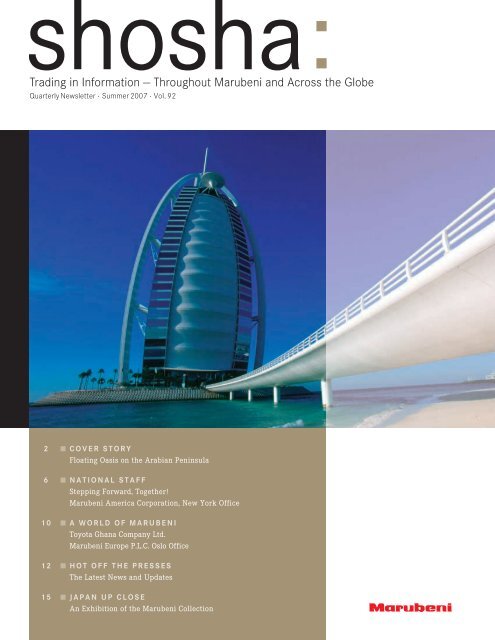
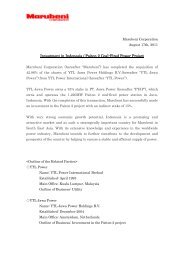
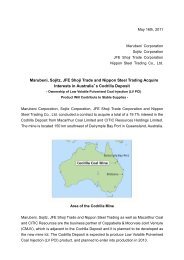
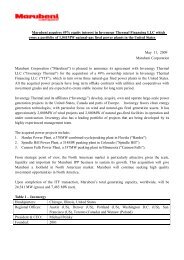
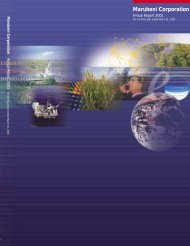
![[Chapter 2] Driving Growth: Expansion Under SG-12 - Marubeni](https://img.yumpu.com/4161147/1/190x248/chapter-2-driving-growth-expansion-under-sg-12-marubeni.jpg?quality=85)
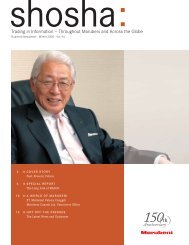


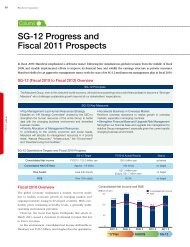
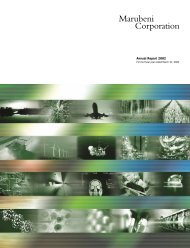
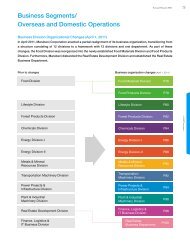
![[Chapter 4] Delivering Growth - Marubeni](https://img.yumpu.com/3464783/1/190x248/chapter-4-delivering-growth-marubeni.jpg?quality=85)
